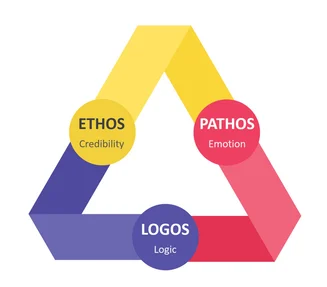I am a big believer that value selling is a key element of successful B2B sales. It is based on the belief that customers are more interested in the business value of your offering than its features or attributes. And it requires a persuasive economic argument for the value of your product or service.
According to Aristotle, the three most important aspects to creating a persuasive argument are ethos, pathos, and logos. Ethos refers to the credibility or authority of the person making the argument, pathos refers to the emotional appeal of an argument, and logos refers to the logical appeal of an argument.
All three aspects are essential to value selling in a business environment. But when money is tight, logos often becomes more important because customers tend to make rational decisions based on the business impact of a product or service.
Logos
The logos of value selling involves using evidence and reasoning to convince customers, especially the CFO or buying committee, that your offering will provide significant business impact. A logical appeal can be even more effective in lean times because customers prioritize financial justification over emotional or social factors.

Value calculators are an ideal way to demonstrate that your offering saves money in the long run or that it improves productivity and efficiency, which leads to cost savings. The results become the basis for a compelling business case that can accelerate and close more deals.
Often during lean or uncertain times, the CFO will increase the thresholds at which projects can receive funding. This could come in the form of a shorter payback expectation, or a higher hurdle rate needing a higher ROI. ROI tools can turn the project economics into the metrics used by the CFO to approve the investment: ROI, NPV, and Payback Period.
Pathos
Pathos is the emotional appeal of an argument that helps customers envision the positive changes that are possible after implementing your solution. This can be as simple as a desire to work with you and your company or as complex as a vision to make the world a better place. While pathos may not sway the CFO or those focused on more immediate, practical benefits, it may appeal to someone on the buying committee who is willing to sponsor and champion your solution within the greater organization.
Incorporating pathos into your value selling process can involve using stories, metaphors, and other rhetorical devices to create an emotional connection with the customer. For example, a salesperson might share how a particular product helped a customer solve a difficult problem, or how it improved their quality of life. Having a diverse library of case studies and anecdotes available to the sales team can help them better connect with customers.
Ethos
Ethos is the credibility or authority of the person making the argument. Customers are more likely to trust and follow the advice of someone who has proven that they understand their business and their industry, and that they have helped others solve similar issues. To some extent, ethos is the cost of entry when it comes to sales.
Ethos is always important. Even if you have established an emotional connection and estimated significant financial returns, if the buying committee doesn’t believe you are credible, they won’t move forward.
Credibility begins with a technical demonstration that your offering can do what you claim it can do. But it also means that your logos argument must be believable and supported by all available evidence. It doesn’t matter if you believe the estimates to be true; what matters is that the customer believes them to be true.
Demonstrate your understanding of their business using a consultative selling approach during your discovery phase to identify and quantify the problems at hand. Then provide relevant references and testimonials from satisfied customers that had similar problems. Engaging with your customer and building a mutually agreeable business case applies the full force of your arguments and delivers more positive sales results.
Conclusion
Value selling involves using all three aspects of a persuasive argument to convince customers of the value of your offering: logos, pathos, and ethos. When money is tight, logos becomes more important because customers are more likely to make rational decisions based on economic benefits. Ethos and pathos are still important but on their own, they may not be enough to gain approval to move forward and close the deal.
By emphasizing the economic value of your offering while establishing credibility and a connection with your customer, you can create a persuasive argument that leads to a successful purchase decision.
How Can ROI Selling Help?
Here’s how ROI Selling can help you thrive in tough times.
- Provide consulting services to help you develop or refine your value-based pricing
- Build ROI tools to justify your pricing and close more deals
- Deliver value-based sales training and program roll-out support

Resources
Connect with Darrin Fleming on LinkedIn.
Join the Value Selling for B2B Marketing and Sales Leaders LinkedIn Group.
Visit the ROI Selling Resource Center.














